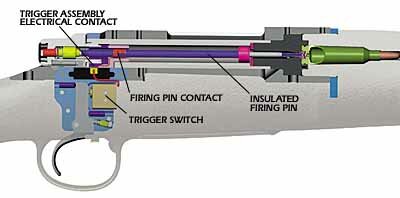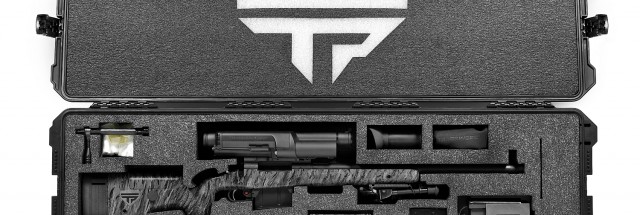Forest Green
ACCESS: Above Top Secret
- Joined
- 11 June 2019
- Messages
- 9,518
- Reaction score
- 17,430
That's a fair point but I can also see an accuracy advantage to a non-physical mechanism. I imagine there's a safety too.Negligent discharge waiting to happen.
Negligent discharge is user error, finger on the trigger when not intending to shoot.Negligent discharge waiting to happen.
The physical pull of a trigger impacts on accuracy in long-range shooting, that's why they're instructed to squeeze the trigger steadily.Negligent discharge is user error, finger on the trigger when not intending to shoot.
Accidental discharge is when the user's finger is not on the trigger and it goes bang anyways.
=====
I'm not sure I see the point for an electronic trigger that doesn't include the TrackPoint aiming software. With that setup, you lock the target in the scope and then pull the trigger. Gun goes off when the point of aim lines back up with the locked point of impact, unless you take your finger off the trigger before it goes bang.
Lock time as well. That is, the length of time between the trigger releasing the sear and the firing pin impacting the primer. But the MDT thing in the video looks (and sounds) like just making the sear release electronically-actuated and still using the normal bolt and firing pin, which is honestly closer to an old-school set trigger than a truly electronic one.The physical pull of a trigger impacts on accuracy in long-range shooting, that's why they're instructed to squeeze the trigger steadily.

Because the rifle moves slightly as you squeeze the trigger, as your heart beats, etc ad nauseam.The physical pull of a trigger impacts on accuracy in long-range shooting, that's why they're instructed to squeeze the trigger steadily.
I'd forgotten about that thing. Has a ballistic computer in the sight:Negligent discharge is user error, finger on the trigger when not intending to shoot.
Accidental discharge is when the user's finger is not on the trigger and it goes bang anyways.
=====
I'm not sure I see the point for an electronic trigger that doesn't include the TrackPoint aiming software. With that setup, you lock the target in the scope and then pull the trigger. Gun goes off when the point of aim lines back up with the locked point of impact, unless you take your finger off the trigger before it goes bang.

Or you make a mechanical set trigger.But a simple electronic trigger would probably be cheaper than a computerised solution. I mean you could just use guided bullets if cost is no issue.
That may actually be the best use for an electronic trigger...I recall reading about a police sniper system where multiple snipers could aim, and press the trigger when ready, but a higher up leader could press a button to fire them all simultaneously. Might have applications when you need to take down multiple bad guys at the same time.
Or you make a mechanical set trigger.
Unless the electronics are adding something that is basically only do-able by electronics, I don't like adding electronics to firearms.
If you're using a solenoid to drive the firing pin, that may be more reliable than a mechanical spring, and in any event could still use mechanically primed ammunition.The obvious reasoning is that an electric solenoid would almost certainly be more reliable than a mechanical trigger, last longer, and take more abuse. At least, that is if aviation electric solenoid versus ground mount spade gripped/butterfly triggered machine guns have anything to say about it. Not only would it would also eliminate some of the more notorious and frustrating failures of conventional triggers, such as hammer spring failures, it would probably be cheaper over the course of production of a firearm.
The downside is that you have to replace (tens? hundreds of?) billions of dollars worth of infrastructure and stockpiled ammunition. That's it. Which is why the relative unreliability of mechanical triggers to electronic triggers is accepted as being less important than the absolute reliability of a firearm in a soldier's hands.
If you're using a solenoid to drive the firing pin,
And from watching channels like Anvil Gunsmithing, you apparently have a lot of warning of a weakening spring before it goes into terminal failure.
With electric primers like the E-TronX, the limit is how fast that capacitor recharges. If it takes 1/4 second for the capacitor to charge, that's slower than most people can shoot semi-auto.The other thing that's severely limiting about electronic triggers is that, if I'm remembering properly, the BATFE prohibits using electronic triggers on anything semiautomatic, classifying them as "readily convertible" to full-auto. Which...ergh, they're not wrong, it would be easy enough (though I'm currently braindead and blanking on exactly how), but at the same time any idiot with a hacksaw and some scrap metal can make a Lightning Link that'll achieve the same effect.

I can see that getting popular for the Precision Rifle Competition folks. They're the ones chasing every possible advantage to reduce their group size. And the Voere X3 is already guaranteed to shoot 1/8MOA without the laser primer. That's a 1" group at 800 yards.
THE FUTURE IS HERE: LASER FIRING PIN Ignition System of Voere X3 Rifle
Austrian firearms manufacturer Voere has developed a laser ignition system for their X3 precision rifle.The system consists of a replacement bolt, which has an integral laser instead of the firing pin assembly.The system works with any conventional ammunition with the primer changed to a special...www.thefirearmblog.com
Actually folks mistake the point of electronic triggers , these will appear in small arms for use with FCS-enabled scopes and will add shoot counting and maintenace logs and unauthorised use and person lockout (LE more than military) which militaries actually want.I can see that getting popular for the Precision Rifle Competition folks. They're the ones chasing every possible advantage to reduce their group size. And the Voere X3 is already guaranteed to shoot 1/8MOA without the laser primer. That's a 1" group at 800 yards.
That performance doesn't come cheap, however. The base rifle is on the order of $6k. Then you need a scope, which should set you back as much as the rifle. Leupold need not apply, this is Zeiss, Schmidt&Bender, or IOR turf.
Smart triggers that only unlock for the authorized users have a significant issue in military or LE circles:Actually folks mistake the point of electronic triggers , these will appear in small arms for use with FCS-enabled scopes and will add shoot counting and maintenace logs and unauthorised use and person lockout (LE more than military) which militaries actually want.
I can see electric primers or laser primers being good for caseless ammo (assuming primers burn up completely), as well as for precision rifle competition.Laser or electricity initated priming is at present limited more by the ammo manufacturers and primers than anything else , there is no market for it , but once a miltary customer wants 100mio + rounds and is willing to pay for R&D it will become common
Do you shoot recreationally? I can field strip an AR type in under a minute. I can detail strip a 1911 in under 3 minutes, completely disassembling the pistol to component parts.Those fears have been around for decades but at one point these triggers will be deemed reliable enough, on the other hand, how many cops are shot with their own guns, how many soldiers by terrorists they are training in xyz country
Sure you could hack and modify the trigger , but its not something that could be done in the field much less in the heat of the moment .
The benefits far outweigh the risks , and military and LE are actualy asking for these features . Fire control being the main for military and access and logging for LE.
I shoot competitively and do dabble firearms design and sniping gear design professionally. At present finishing up a subcompact 300BLK integrally suppressed carbine for a mil customer,100% own design.Do you shoot recreationally? I can field strip an AR type in under a minute. I can detail strip a 1911 in under 3 minutes, completely disassembling the pistol to component parts.
In the field it's trivial to have access to the trigger system to be able to break the smart systems. But yes, it's unlikely to be doable in the heat of the moment.
It just means that any stolen firearm can be assumed to have a broken smart trigger within the day it was stolen. Or less.
What I'm getting at is the designed failure mode, some product liability pain, and how that means the weapons won't be secure 5 minutes after they're stolen.I shoot competitively and do dabble firearms design and sniping gear design professionally. At present finishing up a subcompact 300BLK integrally suppressed carbine for a mil customer,100% own design.
As i do have lots of interaction with military SF units and with optics manufacturers and am seeing lots of electronics being added to optics, the electronic trigger is definitely next step up . Its might not be today or in next 3 years but in 10 years i reckon there will be lots of them around.
Again misconceptions abound , electronic trigger is in many ways still 100% mechanical trigger and if one wanted a ''manual override'' is doable .
A with real FCS , you basically squeeze the trigger and the solenoid will only give way once FCS gives command, after it establishes a firing solution with near 100% hit rate , yes first use will be in sniper rifles ,but DMR and assault rifles will not be far behind as will the grenade launchers
Miltary has relied on electronics in all facets for past 40years , a SF sniper pair carries cca 150k$ worth of gear on the pair and most of that is electronics. You can dabble all youw want about how it going to fail , but without it you are severely reduced in capabilty.
Cars ,planes ,space craft ...........rely on electronics near 100% ,no one in their right mind is skipping electronic for fear of them might fail.
